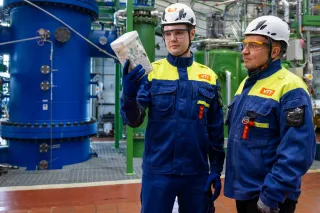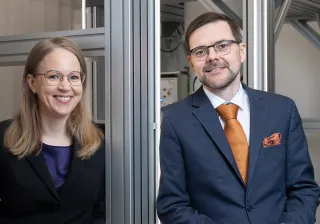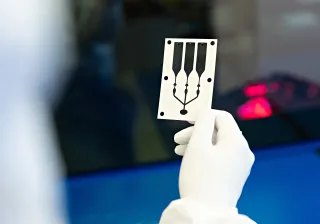Convion Ltd. and VTT are opening up export markets for fuel cell systems that generate electricity and heat from biogas. Convion is currently seeking funding for its internationalisation.
Convion has delivered a fuel cell system to Turin, Italy, in cooperation with VTT. The first of three fuel cell units began operating in October. The second unit is being built and the third phase is under planning. According to Erkko Fontell, the CEO of Convion, user experiences have been excellent in the first one thousand hours.
– We have achieved our target of 53% efficiency in electricity generation. There are practically no emissions and the fuel cell equipment runs without disruption, Fontell says.
Although the power plant has run smoothly, repairs were needed in the system supplying biogas to the fuel cell in the wastewater treatment plant. However, Fontell points out that these problems have been solved.
The power plant uses otherwise unused biogas from the wastewater treatment plant to generate electricity. The biogas is also used to generate heat. The fuel cell system can be remotely controlled from Finland.
– At best, a wastewater treatment plant can be made fully energy self-sufficient with the help of the fuel cell system. The system now being delivered to Italy will provide around 30 percent of the treatment plant's electricity and 100 percent of its heat, says Senior Scientist Markus Rautanen of VTT.
Finished product
Convion, which spun off from Wärtsilä in 2013, is continuing the development of fuel cell technology begun by Wärtsilä and VTT in the early 2000s. The delivery to Italy – the so-called DEMOSOFC project – is an important step in the product's commercialisation.
The five-year DEMOSOFC project (2015– 2020) received EUR 4.2 million from the EU Horizon 2020 programme. The project budget is EUR 5.9 million.
– We have a finished product, have verified that the technology works and have made the first deals. We now aim to expand our operations and make a carefully managed entry into the international market, says Fontell.
For its internationalisation, Convion is seeking another investor alongside the fund managed by its current main investor, the venture capital company VNT. VNT is the majority shareholder in Convion. Wärtsilä has a stake of under twenty percent and the employees own some shares.
The company's internationalisation is being assisted by its long-term research and development, during which VTT and Convion have networked with European research institutes and other actors in the sector. A multinational consortium is also participating in the Italian project. In addition to the DEMOSOFC project, fuel cell systems and stacks are being developed in ventures such as the European INNO-SOFC and qSOFC projects coordinated by VTT.
Convion has also opened up markets in Finland. The company is providing Lempäälän Energia Ltd. with a fuel cell plant which will generate basic power for companies in the business park. The LEMENE project is a key energy technology project of the Ministry of Economic Affairs and Employment.
The project will involve building a selfsufficient, smart network to secure the electricity supply of local businesses. Solar energy, energy storage, gas engines and fuel cells will be used for energy production. The network is due for completion in 2019.
Superior efficiency
In terms of its size class and technology, the fuel cell plant delivered to Italy is the first of its kind in Europe. Compared to competing fuel cell technologies, the key advantage of a solid oxide fuel cell system lies in its ability to use conventional fuels, such as natural gas and biogas, instead of pure hydrogen.
– The technology is ideal for mass production. Cheap raw materials and the ability to use different fuels make this a highly competitive and future-proof technology in solid-fuel heat and power generation plants, says Fontell.
A solid oxide fuel cell power plant is far more efficient than facilities using other technologies. It produces twice the amount of electricity from the same amount of biogas compared to microturbines, and more than one-and-a-half times that of a gas engine.
Fontell and Rautanen point out that, due to their long-term development work, Finns have developed unique expertise. Elcogen Oy, which participated in the development of the fuel cell components, was involved in the projects alongside VTT and Convion.
Ultimately, the solid oxide fuel cell is only the core of the system. A product is being built around it which includes integrated systems and measurement, regulating, control and power electronics.
A promising market
The world market for fuel cells is now estimated to be worth around EUR 3 billion. Less than half of this is based on deliveries of solid-fuel electricity and heat production applications.
Fuel cells are also used in cars and other vehicles, backup power applications, and portable devices in particular. The total market is projected to grow to EUR 14 billion by 2024.
Solid oxide fuel cells are ideal for electricity and heat production when bio or natural gas is available as a fuel. For example, biogas is produced by wastewater treatment plants and biomass-digestion plants. In Europe alone, there are tens of thousands of digestion plants of this type and of various sizes.
Asia, where natural gas is generally used for the production of electricity and heat in buildings, also offers a promising market. A fuel cell power plant can ensure an uninterrupted energy supply in locations where this is particularly important. Such locations include hotels, cold stores and hospitals.
– Because fuel cell plants are quiet and zero-emission, they can be located in real estate deep within urban areas.
According to Markus Rautanen, fuel cell technology is a very promising mode of production during the shift from centralised to decentralised energy-production systems, when solar and wind energy, energy storage and local power generation are being harnessed.
Erkko Fontell believes that there will be a boom in the use of fuel cell technology similar to the growth in solar energy use.
Power generation of this kind is efficient and low-emission
A fuel cell can produce electricity anywhere, efficiently and with low emissions. Fuel cells are not dependent on weather conditions, but work as long as they are supplied with fuel, such as biogas, natural gas, methanol, diesel or hydrogen.
Fuel cells are already being used as power sources for vehicles, and for basic power generation for homes and large properties. The technological benefits are reliability and highly efficient power generation.
Fuel cells are highly dependent on electrolysisbased hydrogen production. For this reason, hydrogen production methods and the quality of hydrogen are important research topics at VTT.
SOFC as an energy source?
By using solid oxide fuel cells (SOFC), energy is made out of fuel and air. The most notable advantage compared to existing fuel cell technologies is the possibility of using conventional fuels such as natural gas, diesel fuel and biogas, instead of hydrogen. The fuel and the oxygen in the air injected into the fuel cell produce a direct electrochemical reaction in the cell, generating electricity and heat.
The advantages of fuel cell technology over competing technologies are emphasised in small, less than 1-MW plants. Convion's fuel cell power plant operates at an electrical efficiency rate of over 53%, thus producing up to twice as much electrical energy as power plants using traditional technologies.




